Necromancer - Spiritual Powers - Tier 7
Like the Mathematician, the Necromancer is a "scholarly" character class that has poor combat skills and low hit point accumulation. However, while the Mathematician uses abstract mathematics and physics to reveal the secrets of the Universe, the Necromancer seeks to do so through biology and arcane lore. Necromancers have seven Tiers of spells. While it is theoretically possible for a Necromancer to be of "good" alignment, many either start off evil or are seduced by the darkness over the course of their careers.
Quick Links: Tier 1 | Tier 2 | Tier 3 | Tier 4 | Tier 5 | Tier 6 | Tier 7
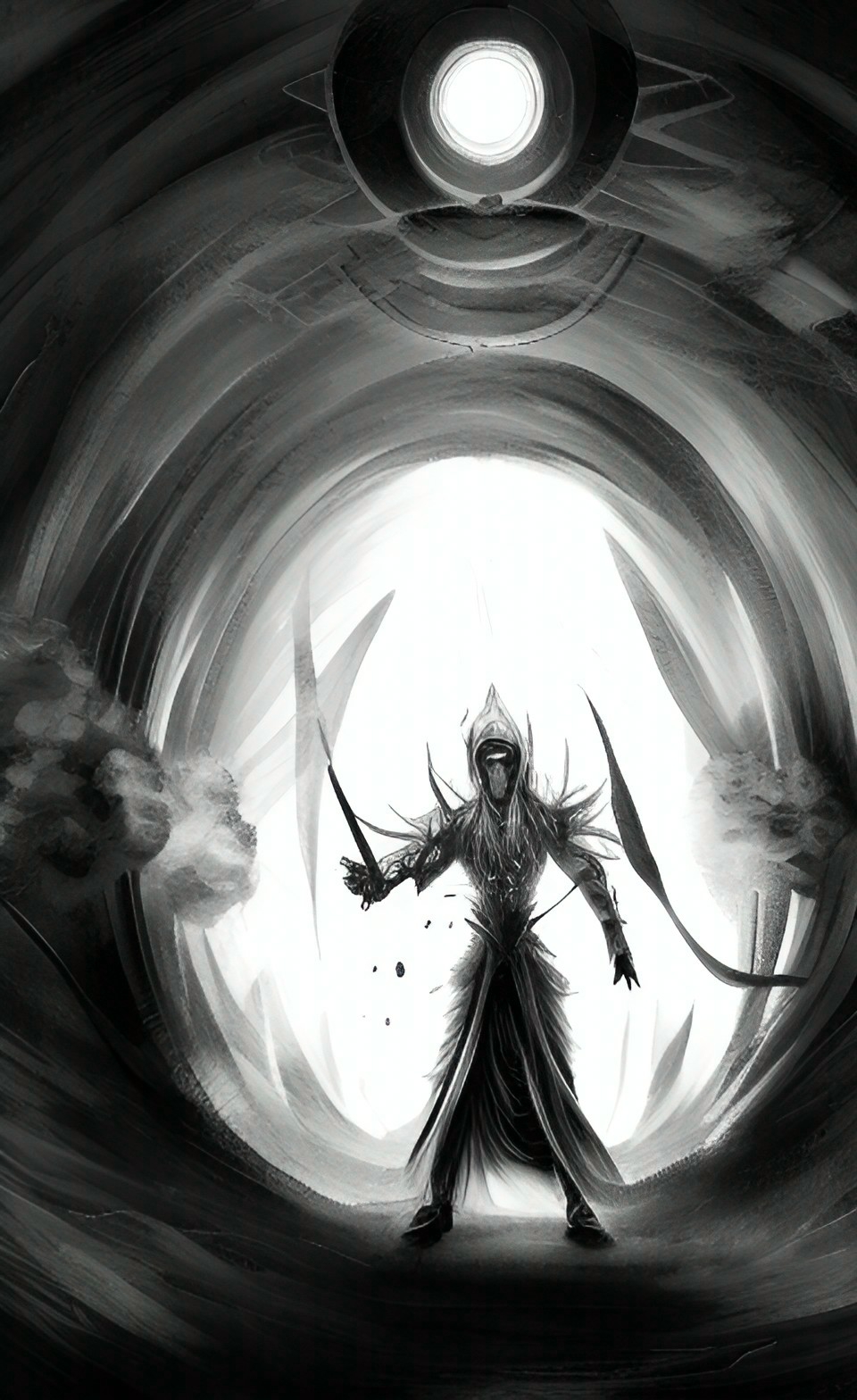 Banish
Banish
Tier: 7
Casting Time: 1 round
Area of Effect: 1 person (or one object of up to 300 pounds)
Range: 10// line of sight
Duration: Permanent
Arcane Focus: Any object obtained from the Plane of Shadow or Conflagration
B-M-S Cost: 2.0 (Shadow); 3.0 (Conflagration)
Classification: Travel
The Arcane Focus for this spell is any small object (pretty much any object at all) that has been obtained directly by the Necromancer from either the Plane of Shadow or the Plane of Conflagration. The focus is not expended in the casting of this spell.
This spell is essentially a "remove a piece from the chessboard" spell. When the Necromancer casts this spell, a portal to either the Plane of Shadow or Plane of Conflagration opens behind the Necromancer's target and attempts to drag the target through the aperture. The portals have an effective Endurance of 13. To escape the grip of the portal, the target must make three consecutive successful Endurance checks (in this case matching Endurance vs Endurance on the Universal Matrix). If the first check is successful, the target advances five feet. If the second check is successful, the target advances another five feet. A third successful check frees the target from the portal's influence. A failed check, however, will cause the target to lose five feet of advancement.
The spell does not actually cause any damage to the target. However, if the target is teleported away to another plane of existence, then that target must find his/her way back to the material plane on his/her own. For instance, Necromancers and Mathematicians have the ability to walk between planes of existence. It should be known that the survivability of the Plane of Shadow is much higher than that of the Plane of Conflagration.
The Necromancer can, of course, target non-moving or non-living objects. For instance, the Necromancer could banish a suitcase nuke or a large pile of medical waste. Being rid of a dead body that is riddled with contagion is a snap with Banish. Inanimate or non-resisting objects are automatically Banished.
If used against a creature that has been summoned from another plane of existence (such as an elemental or a demon), then the Necromancer simply matches his/her Willpower against that of the target creature. A successful outcome for the Necromancer indicates that the targeted creature is returned to its home dimension (as opposed to the Plane of Shadow or Conflagration). It does get a brief glimpse of the referenced plane en route to home, however.
The Portal has a stronger pull when cast by a more powerful Necromancer.
- Levels 1 to 4: The Portal has an Endurance value of 13.
- Levels 5 to 9: The Portal has an Endurance value of 14.
- Levels 10 to 14: The Portal has an Endurance value of 15.
- Levels 15 to 19: The Portal has an Endurance value of 16.
- Levels 20 and higher: The Portal has an Endurance value of 17.
Changes from the printed (book) version: This is a new spell.
 Bone Tornado
Bone Tornado
Tier: 7
Casting Time: 1 round
Area of Effect: Cylinder with 2// base and 8// high
Range: 15// line of sight
Duration: 1 round per level
Arcane Focus: A jar of shattered bones, robbed from a grave
B-M-S Cost: 8.0
Classification: Combat
The Arcane Focus for this spell is a jar filled with the purposefully shattered bones of a sentient humanoid. The bones must have been stolen from a grave. If the bones come from a person who actually died in a hurricane, tornado, waterspout, or windstorm, the duration is doubled, and the damage is enhanced. The focus is expended in the casting of this spell.
When the Necromancer casts this spell and opens the jar of shattered bones, the fragments swirl upward and multiply until they form a rapidly spinning vortex comprised of razor-sharp bone fragments. The Necromancer can direct the Bone Tornado at the rate of 5// per round. Any foe caught within the area of effect can attempt a Save versus Area Effect for half damage. The spell has variable damage depending on creature type and the quality of the Arcane Focus.
| Creature Type | Standard Focus | Enhanced Focus |
| Constructs | 6d20 | 9d20 |
| Living Beings | 9d20 | 12d20 |
| Undead | 12d20 | 15d20 |
If the Necromancer is Undead, swap the damage values for living and Undead targets.
The Bone Tornado gets larger as the Necromancer ascends in level.
- Levels 1 to 4: The cyclone has a 2// base and is 8// tall.
- Levels 5 to 9: The cyclone has a 2// base and is 9// tall.
- Levels 10 to 14: The cyclone has a 3// base and is 10// tall.
- Levels 15 to 19: The cyclone has a 3// base and is 11// tall.
- Levels 20 and higher: The cyclone has a 4// base and is 12// tall.
Changes from the printed (book) version: The damage is increased in keeping with the spell level. This is now essentially a weapon of mass destruction.
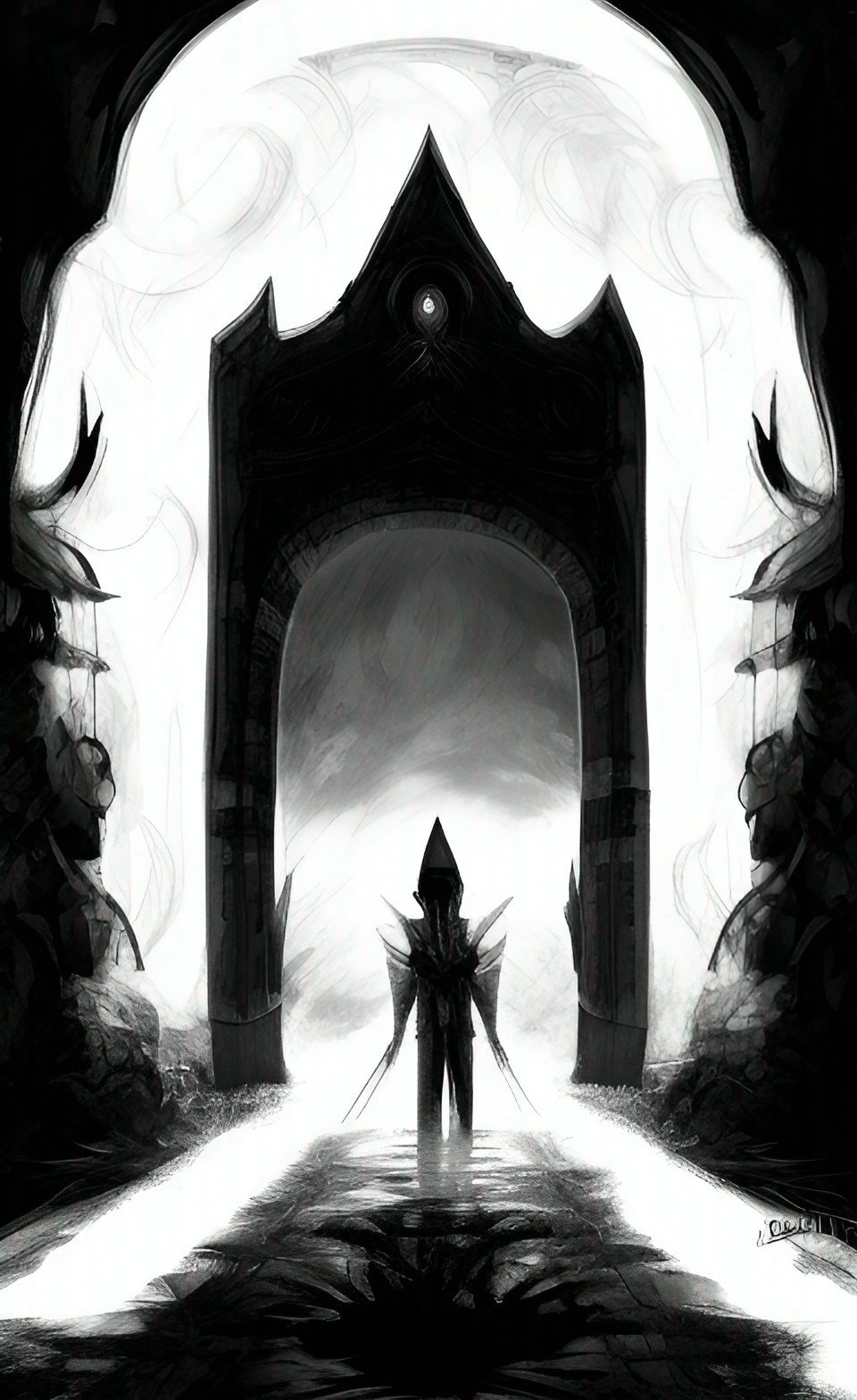 Death's Gate
Death's Gate
Tier: 7
Casting Time: 1 turn
Area of Effect: The Necromancer
Range: Internal to the Necromancer
Duration: Quiescent until triggered, then instantaneous
Arcane Focus: A hollow crystal containing the Necromancer's blood
B-M-S Cost: 1.0 per 100 miles teleported
Classification: Travel and Healing
The Arcane Focus for this spell is a hollowed-out crystal that contains at least 1 cc of the Necromancer's blood. The arcane focus is not expended when the spell is cast, but it is expended when the spell is triggered.
When preparing this spell, the Necromancer must first fill a hollowed-out crystal with at least 1 cc of his/her own blood. Once this is done, the Necromancer can transfer an allotment of hit points, spirit points, BMS, or Primary Attributes in any quantity that he/she sees fit -- up to one-half of the Necromancer's maximum. Transferred points recover naturally over time (usually at the rate of one point per day). Once the transfer is complete, the crystal permanently seals, and no further additions are possible.
The triggering event for Death's Gate is if the Necromancer's hit points, BMS, SP, Willpower, or Endurance are brought to zero. Once triggered, the Necromancer is brought to a predefined safe place (usually his/her laboratory that may also be stocked with healing potions, anti-radiation serum, antibiotics, and antitoxin potions). If the distance is too great (i.e., the Necromancer's available BMS is insufficient), the Necromancer will still be transported to some random place of relative safety in the direction of the predefined destination. For example, if the Necromancer is brought to 0 Willpower and he/she still has 7 points of BMS, and the predefined destination is 800 miles away, the Necromancer will be transported to a relatively safe spot 700 miles in the direction of his/her intended destination. In the event that the Necromancer sustains a BMS injury (i.e., he/she is siphoned to BMS(-3) by some other Necromancer's Soul Devourer), the spell will still trigger but will only transport the injured Necromancer one mile in the direction of the intended destination. In any event, the spell will prioritize hospitals or clinics as a "relative place of safety" if the predefined location is not available.
Upon rematerializing, all of the energy stored in the spell crystal transfers to the Necromancer. Thus, if the Necromancer stored 25 hit points, 10 spirit points, 1 point of Constitution, 1 point of Strength, and 5 points of BMS, all of that energy would transfer into the Necromancer at once. The Necromancer cannot make a partial withdrawal. The crystal shatters into a pile of dust once the transaction is completed.
If the crystal is stolen, the thief in question could attempt to utilize the stored energy by purposefully breaking the crystal. The stored points would transfer to the thief, but the teleportation function would transport the person to a wholly random (but still safe) place within the limits of the thief's BMS. Alternatively, the Necromancer could willingly give a Death's Gate crystal to an ally. Whether the Necromancer tells the friend about the random teleportation aspect is at the giver's personal discretion.
A Necromancer can create more than one Death's Gate crystal (albeit not on the same day). A secondary or successive crystal cannot be fabricated until the Necromancer has fully recovered from making the first crystal. If a Necromancer has more than one active crystal, one only will ever be triggered in any single 24-hour period.
Changes from the printed (book) version: The energy reserve now comes from the Necromancer and not from other people/creatures.
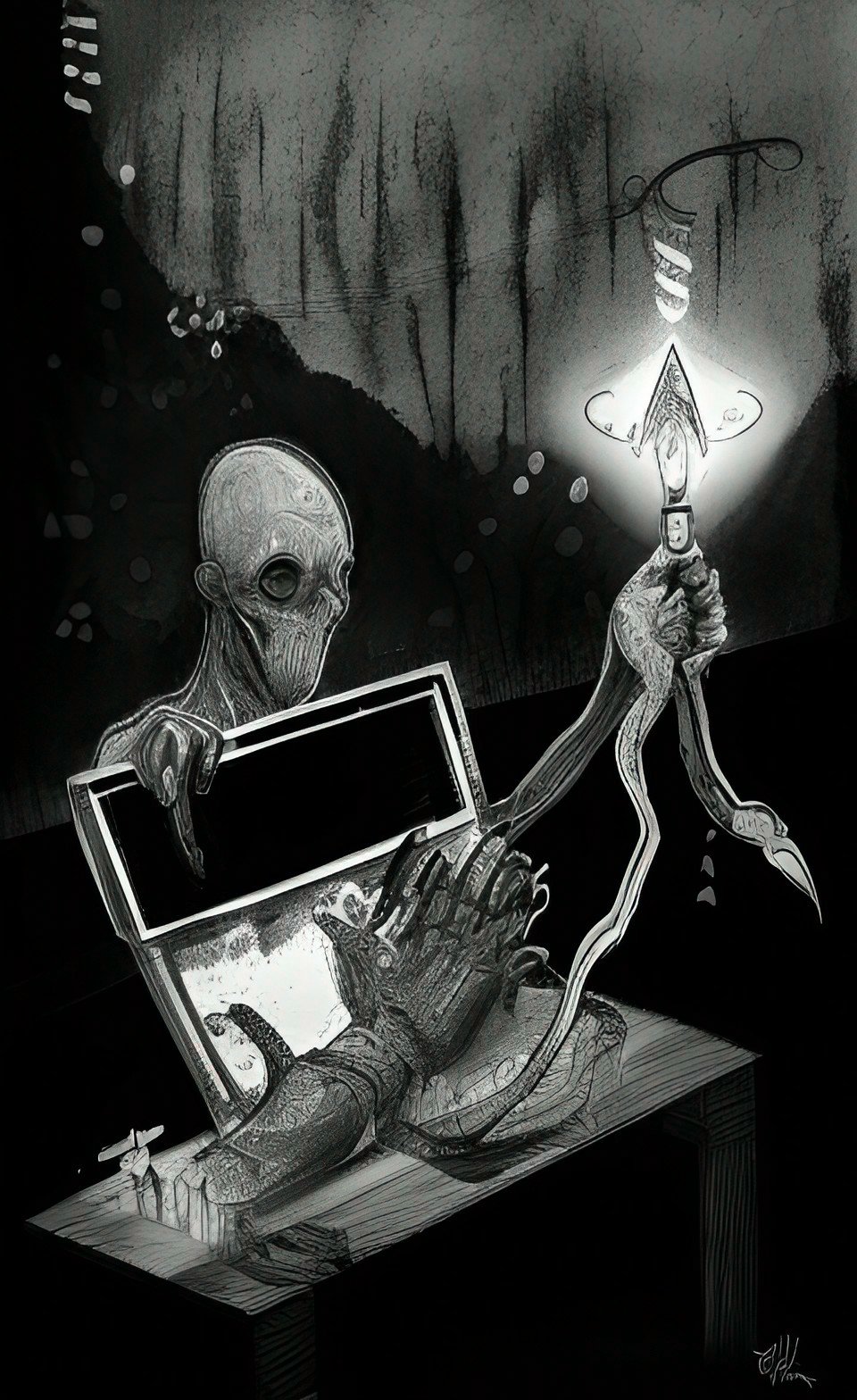 Imbue
Imbue
Tier: 7
Casting Time: 1 turn
Area of Effect: One object
Range: Touch
Duration: Permanant
Arcane Focus: The object to be enchanted
B-M-S Cost: Special
Classification: Enhancement / Enchantment
The Arcane Focus for this spell is the object to be enchanted. The focus is obviously not expended in the casting of this spell.
This spell is of the variety that requires that the Player and Game Master to cooperate in determining how this spell will function. The purpose of the spell is to permanently imbue a mundane object with supernatural power (or add a power to an already-enhanced object). The Player must submit a proposal to the Game Master with how the object shall be enhanced. The Game Master may approve, modify, or refuse the proposal. If approved, the Game Master will advise the Player as to the BMS cost, material cost, and time required for research.
Should the enchantment check fail, the item is not destroyed, but the Necromancer will have still expended BMS. The Necromancer can always make another enchantment attempt on another day. Enchantments completed by a Necromancer should be in keeping with the theme of Necromancy. For example, supernatural effects that cause disease, poison, darkness, or pain would be in keeping with the theme of Necromancy. Supernatural effects pertaining to the production of food, light, pleasant scents, and renewed sanity would not be in keeping with the theme of Necromancy. Likewise, spell effects of a "vampiric" nature (siphons points from one target and gives to another) would be appropriate while simple magical healing would not be.
Generally speaking, supernatural objects can only retain four degrees of enchantment. Also, the Necromancer may be granted bonuses to the casting check if he/she has Artistic Ability and is enchanting a high-quality item.
Changes from the printed (book) version: This is a new spell.
 Resurrect
Resurrect
Tier: 7
Casting Time: 1 round
Area of Effect: 1 person
Range: 1//
Duration: Permanent
Arcane Focus: The body of the person to be resurrected
B-M-S Cost: 1.0 per level or hit die of the resurrected person
Classification: Healing
The Arcane Focus for this spell is the body of the person to be resurrected. The focus is obviously not expended in the casting of this spell. However, Resurrect does have an additional requirement of the Necromancer: the caster must expend one point of Willpower per day that the recipient has been dead (this could be zero if the person is resurrected immediately following death). If the length of time dead exceeds the Necromancer's Willpower score, the soul of the departed is effectively out of reach and the spell will fail.
This spell will also require a well-equipped laboratory (with the same standards as in the Clone spell). Should the spell work, the resurrected person will initially be very weak and still require supportive care for several days. Equipment required for this spell: an electrical defibrillation unit (to restart the target's heart), an artificial ventilator, and an adult-sized incubation unit. By the time that a Necromancer is of high-enough level to cast Resurrect, it is surely reasonable that he/she has had sufficient career advancement that such a lab is possible.
Once the spell is cast (assuming that the activation roll is successful), the Necromancer must then activate the defibrillator. At that moment, the Game Master rolls a Save versus System Shock for the deceased, based on the appropriate roll for the character as a living being. At that same moment, the Necromancer transfers one point each from every Primary Attribute from himself to the recipient. If the save is successful, the target's heart starts beating and the Necromancer can move on to the starting the ventilator. If the save is unsuccessful, the Necromancer can try the defibrillator again (and transfer another set of points to the target). This can be repeated until such a time that the save is successful, or the Necromancer is physically/mentally exhausted.
Moving on to the ventilator stage, the Necromancer has to keep the patient breathing for ten rounds. A Knowledge check followed by a Skill check at the end of the ten-round period will determine success. If both checks succeed, the patient can then be transferred to the incubator. If one check fails, the ten-round period restarts. If both checks fail, the Necromancer must once again resort to the defibrillator.
Once placed in the incubator, the patient must remain in-place for one full day until his/her body is sufficiently recovered enough to internally regulate one's body temperature. After that, the patient will recover all attributes at the rate of one point per day rest (the patient starts with a "1" in all Primary Attributes.) Likewise, the Necromancer recovers sacrificed attributes at the natural rate of one point per day (but full bed rest is not required.). It should be known that the temporary loss of attributes does not make the Necromancer stupid and clumsy, but rather reflects the significant mental and physical fatigue imposed by casting this spell.
It should also be known that the root cause of the person's death is addressed by this spell. For instance, Resurrect seals over all open wounds, removes radiation poisoning, chemical poisoning, and all diseases.
Changes from the printed (book) version: This is a new spell.
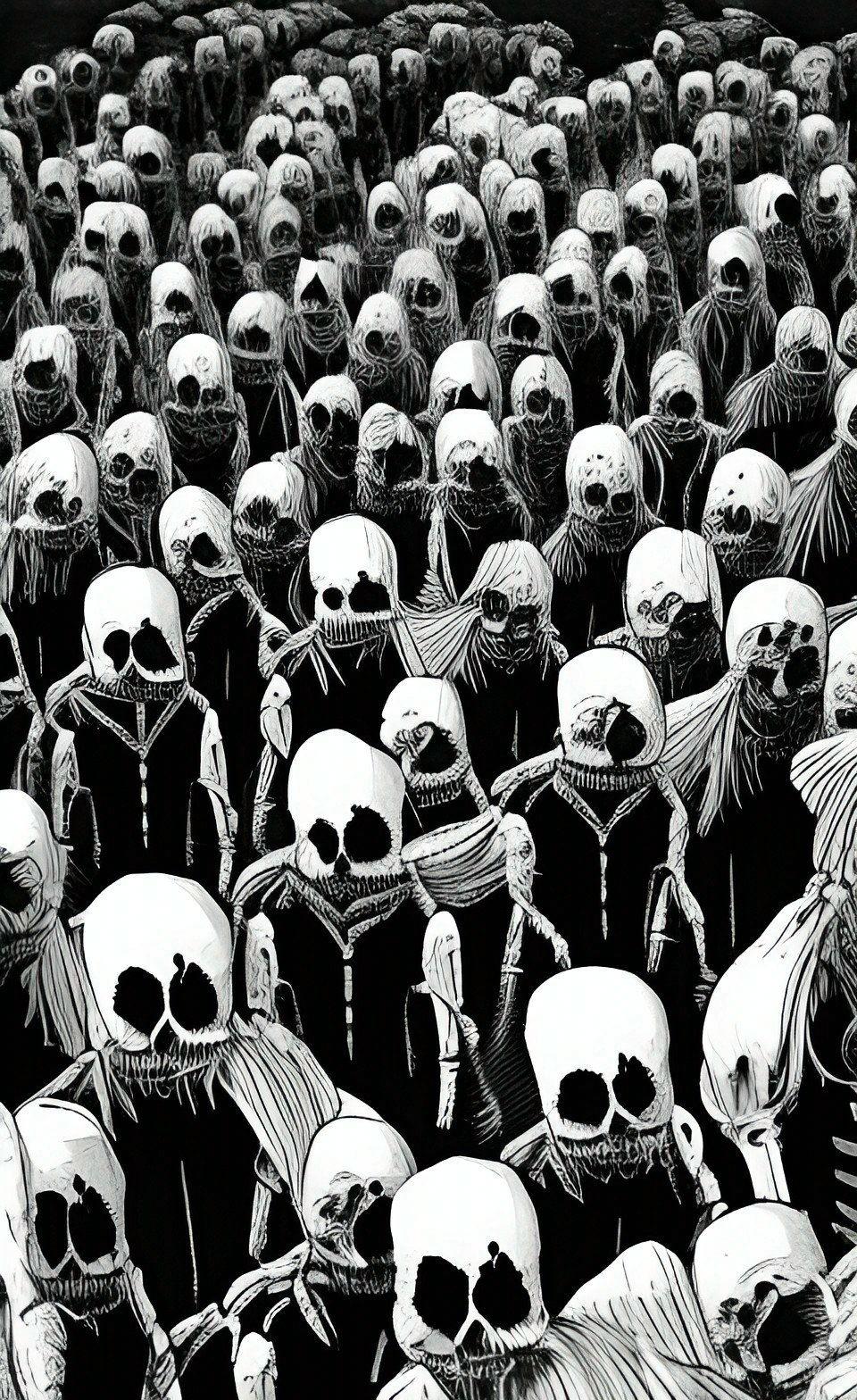 Skeletal Platoon
Skeletal Platoon
Tier: 7
Casting Time: 1 round
Area of Effect: Summoned Skeletons
Range: 20// line of sight
Duration: 1 round per level
Arcane Focus: A skeleton figurine, carved from bone
B-M-S Cost: 0.25 per skeleton summoned
Classification: Combat
The Arcane Focus for this spell is a skeleton figurine carved from bone. If the figurine is carved from a bone derived from a sentient humanoid (as opposed to livestock or a wild animal), then the duration is twice as long, and the spell summons two skeletons per 0.25 BMS. The focus is not expended in the casting of this spell.
The main purpose of this spell is to create a wide-area nuisance for the Necromancer's foes. When this spell is cast, the Necromancer causes a portal to the Realm of Shadow to open, through which a variety of skeletal troops shamble forth. These creatures all have 5 HD and can be of any mix of the following profiles:
The primary purpose of these troops is to cause the Necromancer's foes to expend spells, ammunition, and resources prior to actually being able to engage the Necromancer and his/her allies. The Necromancer can personally direct the Platoon's attacks if he/she forfeits all other actions. Otherwise, the skeletons will select their own targets independently from amongst the ranks of the Necromancer's foes.
- Warrior: Attacks with a sword for 1d10 damage.
- Archer: Attacks with a bow for 1d6+1 damage.
- Dirge Master: Attacks with a lute or guitar (5th level Wishsinger equivalent).
- Devil Dog: Skeleton hound that bites for 1d6 damage.
Like many other summoning spells, Skeletal Platoon can be terminated early if the portal to the Shadow Realm is closed, if the figurine is destroyed, or if the Necromancer is killed (or incapacitated).
The quantity of summoned monsters increases as the Necromancer ascends in level.
- Levels 1 to 4: The spell summons five creatures.
- Levels 5 to 9: The spell summons ten creatures.
- Levels 10 to 14: The spell summons fifteen creatures.
- Levels 15 to 19: The spell summons twenty creatures.
- Levels 20 and higher: The spell summons twenty-five creatures.
Changes from the printed (book) version: This is a new spell.
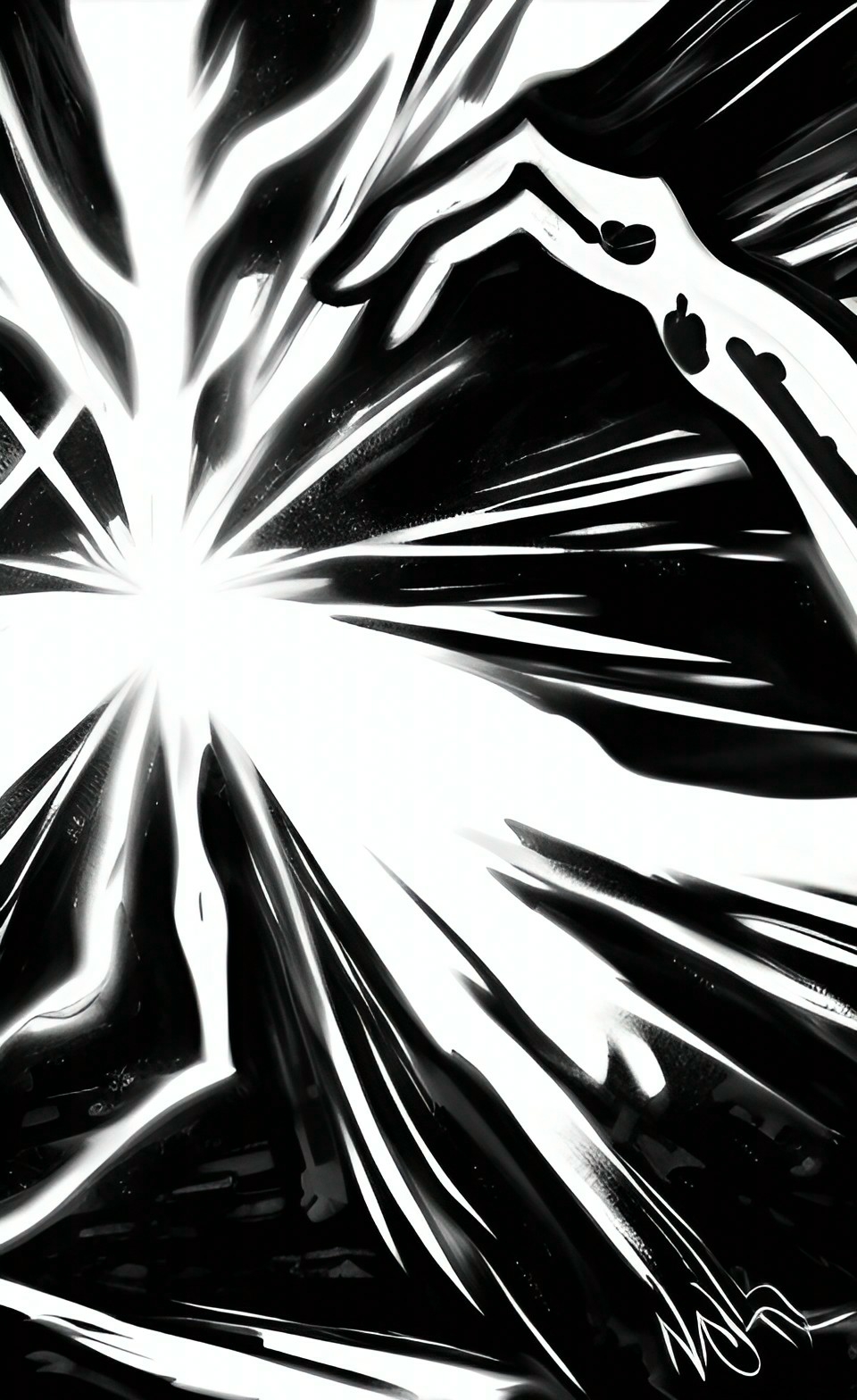 Slay
Slay
Tier: 7
Casting Time: 1 segment
Area of Effect: 1 arrowhead
Range: 10// line of sight (starting from the Necromancer's position)
Duration: 1 round per level
Arcane Focus: An arrowhead carved from bone
B-M-S Cost: 4.0
Classification: Combat
The Arcane Focus for this spell is an arrowhead carved from bone. If the focus is carved from bone derived from a sentient humanoid, then the projectile has a range of 20//. The focus is not expended in the casting of this spell. The BMS cost is reduced by 0.5 if the Necromancer has artistic ability and is the one who carved the item. This spell is essentially a higher-level version of Death Bolt.
When the Necromancer casts this spell, he/she launches an arrowhead against any chosen foe. The Necromancer uses his/her Missile BAtCh score for targeting. The Necromancer can target one creature per round. When applicable, creatures can make appropriate saves for negation for secondary damage. The arrowhead always returns to the Necromancer after every attempted attack, whether or not the attack was successful. The type of damage inflicted depends on the creature type and quality of the Arcane Focus.
| Creature Type | Standard Focus | Enhanced Focus |
| Constructs | 6d20 | 8d20 |
| Living Beings | 8d20 + int(2) poison | 10d20 + int(4) poison + fever disease |
| Undead | 10d20 + 1d4 Willpower | 12d20 + 2d4 Willpower |
If the Necromancer is Undead, the damage values for living and Undead targets are swapped.
The range of the spell increases as the Necromancer ascends in level.
- Levels 1 to 4: The range is 10// line of sight.
- Levels 5 to 9: The range is 13// line of sight.
- Levels 10 to 14: The range is 16// line of sight.
- Levels 15 to 19: The range is 19// line of sight.
- Levels 20 and higher: The range is 22// line of sight.
Changes from the printed (book) version: This spell is no longer an "instant death" spell, in keeping with the Version 2.1 prohibition against "murder" spells.
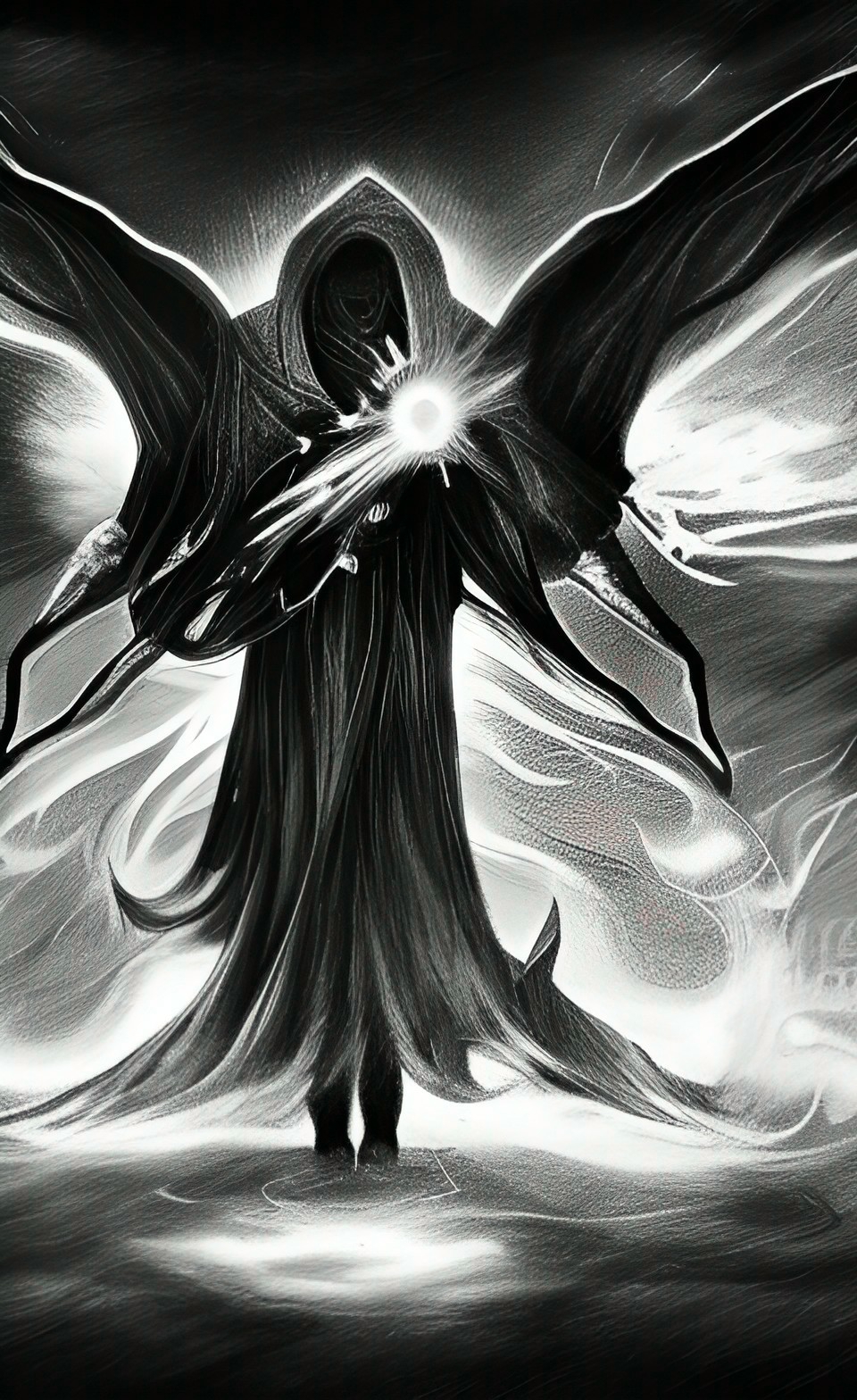 Soul Devourer
Soul Devourer
Tier: 7
Casting Time: 1 round
Area of Effect: 1 summoned creature
Range: 10//
Duration: Line of Sight
Arcane Focus: A Calavera
B-M-S Cost: 4.0
Classification: Combat, Summoning
The Arcane Focus for Soul Devourer is a Calavera. The summoned creature takes on the likeness (albeit a vastly larger likeness) of the Calavera. If the focus is actually constructed from bone derived from a sentient humanoid, the spell lasts twice as long. The focus is not expended in the casting of this spell.
When the Necromancer casts this spell, he/she opens a portal to the Plane of Conflagration through which an angry (and hungry) spirit emerges. The spirit is temporarily granted corporeal form (14d6 HP, AC(1), flight 24//(B), BAtCh = Necromancer's BAtCh, 2 attacks per round (bite 3d6 and breath weapon 3// cone 45 degrees).
Each round, the Soul Devourer can select a target to bite. If successful, the bite transfers hit points from the target to the summoned creature at a 1:1 ratio. The bite is followed by a breath attack. Any foe caught within the area of effect must make a successful Save versus Area Effect or take 6d6 damage to Spiritual Points and 3d6 damage to BMS. Targets brought to zero are rendered comatose until such a time that natural healing brings their point values back to "1" or higher. The Soul Devourer transfers stolen SP/BMS to the Necromancer. If the Necromancer is already at full power, then the over-heal value is transferred to the nearest ally that is not already at full SP/BMS.
The Soul Devourer has a third, less active power. Because it is a powerful being summoned from the Conflagration, it also emanates a Fear effect. Any foe within 12// of the creature must make a Save versus Sleep/Charm or become demoralized by fear (in this case, incur a -2 penalty to all combat and skill actions). A Cavalier within the foes' ranks may be able to counteract the Fear effect. To those who succumb to Fear, he/she will be utterly convinced that the monster actually has the power to eat souls rather than merely drain spiritual potency from its victims.
As with other summoning spells, the Soul Devourer can be defeated if its Willpower is brought to zero via Spirit Combat. Likewise, if its temporary corporeal form is destroyed, the spell is terminated. If the portal to the Conflagration is prematurely sealed, the spell ends immediately. Likewise, if the Necromancer is killed (or incapacitated) or the Calavera is broken, the spell is terminated.
Changes from the printed (book) version: This is a new spell. Also, the creature does not actually devour souls.
Things to Consider
|
